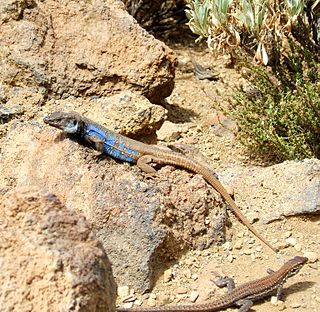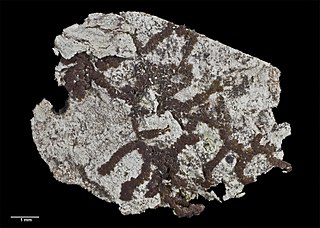
Marsupella profunda, the western rustwort, is a liverwort native to Europe and known only from Portugal and Great Britain (Cornwall) and has been sighted in the Canary Islands. It is a small reddish liverwort and can be confused with Marsupella sprucei which has a more widespread distribution.

Gallotia galloti, also known commonly as Gallot's lizard, the Tenerife lizard, and the Western Canaries lizard, is a species of wall lizard in the genus Gallotia. The species is native to the Canary Islands of Tenerife and La Palma. Unlike most larger species of its genus, G. galloti is a commonly found animal. There are four recognized subspecies.

The Canary long-eared bat, also known as the Canary big-eared bat or Tenerife long-eared bat, is a species of vesper bat endemic to the Canary Islands. According to the IUCN, it is critically endangered. It feeds mainly on moths. Roosting sites include caves, lava tubes and abandoned buildings.
Tritomaria ferruginea is a species of liverwort in the family Lophoziaceae. It is an endangered species endemic to the eastern Himalayas.
Bazzania bhutanica is a species of liverwort in the family Lepidoziaceae. It is a critically endangered species known only from the eastern Himalayas of Bhutan and northeast India.

Frullania polysticta is a species of liverwort in the family Frullaniaceae. It is found only in Madeira and the Canary Islands and is considered a vulnerable species.
Fulfordianthus evansii is a species of liverwort in the family Lejeuneaceae. It is found in Belize, Costa Rica, Guatemala, and Panama. Its natural habitat is subtropical or tropical moist lowland forests.

Picconia excelsa, commonly known as palo blanco, pau blanco, or branqueiro, is a species of tree in the family Oleaceae. It is endemic to Macaronesia, occurring only on Madeira and the Canary Islands.
Riccia atlantica is a species of liverwort in the family Ricciaceae. It is endemic to the Madeira archipelago and the Savage Islands in Portugal. Its natural habitat is rocky shores.
Schistochila macrodonta is a endangered species of liverwort in the family Schistochilaceae. It is found in Bhutan and China. This large, unbranched liverwort, characterised by its shoots measuring 4–6 centimeters in length and distinctive two-lobed leaves with smooth margins, is found only in high-altitude temperate and subtropical forests of Bhutan and China's Yunnan Province, at elevations between 2,730 and 3,580 metres. The species has reddish-brown rhizoids and the unusual presence of bicellular propagules at its leaf tips. Its extremely restricted distribution, known from only a few locations spanning less than 500 square kilometres, has led to its classification as endangered on the IUCN Red List due to ongoing habitat decline.
Spruceanthus theobromae is a species of liverwort in the family Lejeuneaceae. It is endemic to Ecuador, where it is the only liverwort species known to be endemic to the western foothills of the Ecuadorian Andes.

Radula is a genus of liverwort, and is the only genus in family Radulaceae.

Sphagnum palustre, the prairie sphagnum or blunt-leaved bogmoss, is a species of peat moss from the genus Sphagnum, in the family Sphagnaceae. Like other mosses of this type it can soak up water up to the 30-fold amount of its own dry weight thanks to its elastic spiral fibers. S. palustre is rather frequent and is spread almost all over the world. It mainly grows in wet forests and—compared to other specimens of this genus—rarely grows in moors.

Lejeunea hodgsoniana is a species of liverwort in the family Lejeuneaceae. Endemic to New Zealand, it was first recognized in 1980 but not formally described until 2013. The plant forms bright green mats up to 7 centimetres in diameter on tree bark and occasionally on rocks. The species is found from the Kermadec Islands in the north to the Chatham Islands in the south, primarily in coastal and lowland areas below 100 metres elevation. It is distinguished from related species by its relatively large size, multi-celled tooth on the leaf lobule, and deeply divided underleaves with pointed tips. While showing a particular affinity for mahoe trees, it grows on various native and introduced trees and is considered "Not Threatened" under the New Zealand Threat Classification System due to its abundance within its range and ability to grow in both pristine and disturbed habitats.
Cladoradula perrottetii is a species of liverwort is the family Radulaceae. It is distributed across tropical and subtropical Southeast Asia, occurring in Thailand, Sumatra, Taiwan and Japan. It contains the small molecule perrottetinene, a cannabinoid, and other secondary metabolites of scientific interest including marchantin A.

Micromeria glomerata, known locally as cliffthyme or thyme of Taganana, is a species of plant with woody chameleophyte flowers, belonging to the Lamiaceae family. It is a species endemic to the northeast of the Canary Island of Tenerife, whose description was first made in 1974, thanks to botanist Pedro Luis Pérez de Paz. It is a medicinal and aromatic plant with pink-purple flowers that grows at low altitude in the crevices of the slopes of the protected area of the Anaga Rural Park, located in the massif of the same name. The flexible, puberulose stem and with internodes can reach 10 to 40 centimeters in height. On the other hand, the leaves are small and flat, 8 mm long by 6 mm wide.11

Frullania wairua, the spirit liverwort or radar bush liverwort, is a species of liverwort in the order Porellales. It is one of 24 species in the large genus Frullania that are native to New Zealand. The species was first described by Matt von Konrat and John E. Braggins in 2005 in the New Zealand Journal of Botany.
Cladoradula is a genus of liverworts in the family Radulaceae. Distinguished by its thick, brown-pigmented stems and distinctive branching pattern, it comprises seven species found primarily in tropical and temperate forest regions worldwide. Originally established as a subgenus of Radula in 1885, it was elevated to genus rank in 2022 following molecular studies that revealed it represents one of the oldest lineages within Radulaceae, having diverged during the late Permian period about 263 million years ago. The genus is characterised by its specialised stem structure, distinctive leaf arrangement, and small protective structures around its reproductive organs. Species in the genus grow as epiphytes on tree bark or shaded rocks from sea level to over 2000 metres in elevation.










